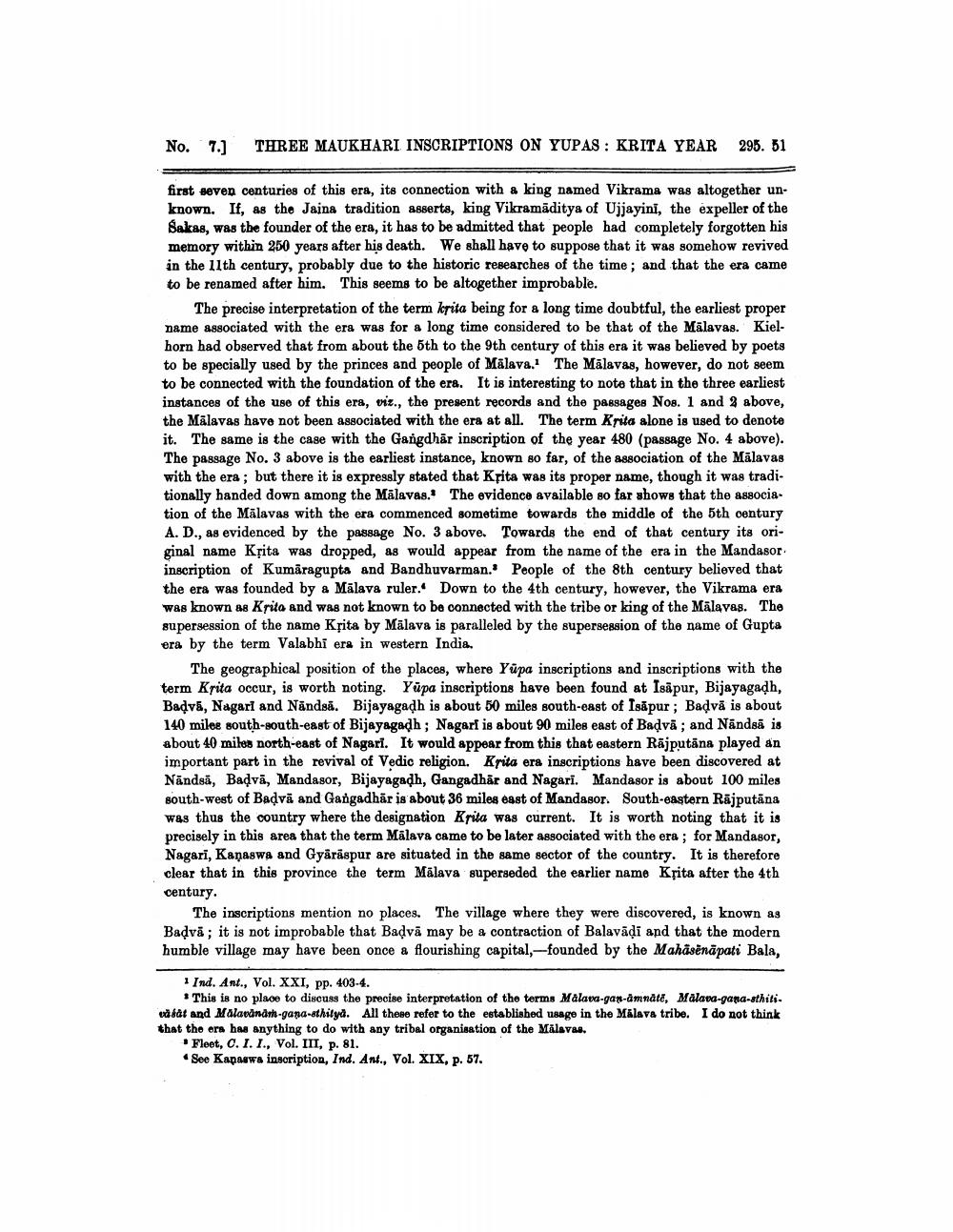________________
No. 7.]
first seven centuries of this era, its connection with a king named Vikrama was altogether unknown. If, as the Jaina tradition asserts, king Vikramaditya of Ujjayini, the expeller of the Sakas, was the founder of the era, it has to be admitted that people had completely forgotten his memory within 250 years after his death. We shall have to suppose that it was somehow revived in the 11th century, probably due to the historic researches of the time; and that the era came to be renamed after him. This seems to be altogether improbable.
THREE MAUKHARI INSCRIPTIONS ON YUPAS: KRITA YEAR 295. 51
The precise interpretation of the term krita being for a long time doubtful, the earliest proper name associated with the era was for a long time considered to be that of the Malavas. Kielhorn had observed that from about the 5th to the 9th century of this era it was believed by poets to be specially used by the princes and people of Malava. The Mälavas, however, do not seem to be connected with the foundation of the era. It is interesting to note that in the three earliest instances of the use of this era, viz., the present records and the passages Nos. 1 and 2 above, the Malavas have not been associated with the era at all. The term Krita alone is used to denote it. The same is the case with the Gangdhär inscription of the year 480 (passage No. 4 above). The passage No. 3 above is the earliest instance, known so far, of the association of the Malavas with the era; but there it is expressly stated that Krita was its proper name, though it was traditionally handed down among the Malavas. The evidence available so far shows that the associa tion of the Malavas with the era commenced sometime towards the middle of the 5th century A. D., as evidenced by the passage No. 3 above. Towards the end of that century its original name Krita was dropped, as would appear from the name of the era in the Mandasor inscription of Kumaragupta and Bandhuvarman. People of the 8th century believed that the era was founded by a Malava ruler. Down to the 4th century, however, the Vikrama era was known as Krito and was not known to be connected with the tribe or king of the Malavas. The supersession of the name Krita by Mälava is paralleled by the supersession of the name of Gupta era by the term Valabhi era in western India.
The geographical position of the places, where Yupa inscriptions and inscriptions with the term Krita occur, is worth noting. Yupa inscriptions have been found at Isapur, Bijayagaḍh, Baḍva, Nagari and Nandsa. Bijayagaḍh is about 50 miles south-east of Isapur; Baḍvā is about 140 miles south-south-east of Bijayagadh; Nagari is about 90 miles east of Baḍvā; and Nandsā is about 40 miles north-east of Nagari. It would appear from this that eastern Rajputana played an important part in the revival of Vedic religion. Krita era inscriptions have been discovered at Nandsa, Baḍvā, Mandasor, Bijayagadh, Gangadhar and Nagari. Mandasor is about 100 miles south-west of Baḍva and Gangadhar is about 36 miles east of Mandasor. South-eastern Rajputana was thus the country where the designation Krita was current. It is worth noting that it is precisely in this area that the term Malava came to be later associated with the era; for Mandasor, Nagari, Kanaswa and Gyäräspur are situated in the same sector of the country. It is therefore clear that in this province the term Malava superseded the earlier name Krita after the 4th century.
The inscriptions mention no places. The village where they were discovered, is known as Baḍva; it is not improbable that Baḍva may be a contraction of Balavāḍī and that the modern humble village may have been once a flourishing capital,-founded by the Mahāsēnāpati Bala,
1 Ind. Ant., Vol. XXI, pp. 403-4.
This is no place to discuss the precise interpretation of the terms Mälava-gan-ämnātē, Mälava-gana-sthitiväsät and Malavänäm-gaṇa-sthilyä. All these refer to the established usage in the Malava tribe. I do not think that the era has anything to do with any tribal organisation of the Mälavas.
Fleet, C. I. I., Vol. III, p. 81.
*See Kapaswa inscription, Ind. Ant., Vol. XIX, p. 57.




